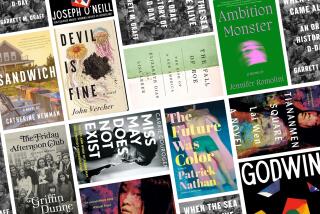The Quarterly: The Magazine of New American Writing Nos. 1 and 2, edited by Gordon Lish (Random House/Vintage: $6.95 paperback; 312 pp. and $5.95 paperback; 249 pp.)
In its recent charting of the firmament of contemporary American letters, Esquire magazine placed its former fiction editor, Gordon Lish, squarely in the âRed Hot Center.â Rightfully so. Lish is the magus of minimalism, the chic aesthetic of the day, and he is exuberantly active on every front. He writes the stuff (his latest novel was âPeruâ), edits it (at Knopf), and teaches its subtle arts in his New York workshops.
Now Random House is underwriting and distributing Lishâs newest venture--The Quarterly, a journal of fiction, poetry and commentary slated to appear seasonally. It is, judging from the first two issues, the glitziest high school literary mag ever produced.
The Quarterly, assertively identified as âthe magazine of new American writing,â is, more accurately, a magazine devoted to a certain strain of that writing: Lishâs strain. The prose is uniformly slick and quirky; it is utterly without emotional muscle--the apotheosis of âcreative writing.â
You can call this a mode, or, if you are less charitable, a disease. Take a look at the first issue. There are 13 stories, and every last one is in the first person (attention: Christopher Lasch). Now read through the openings. Each writer is jockeying for a clever angle on some anxious or terrifying subject. âThe year I began to say vahz instead of vase, â begins Amy Hempelâs âThe Harvest,â âa man I barely knew nearly accidentally killed me.â A similarly discordant note can be heard in stories by Tom Spanbauer, Yannick Murphy, Kaye Gibbons and others.
The overall tactic, passed along in part through Lishâs example and instruction, is simple. Grab the reader with a voice and a hint of terror or calamity. Then string wry, oblique chunks of narrative--observed incongruities from daily life, memories from childhood--into casual, plotless sequences. Trust that the circumvented ugly fact will leave its stain on everything that follows.
Not one of these fictions grapples head-on with sorrow, loss, infirmity, death, or any of the time-honored themes of fiction. They are instead like trailers that precede the feature film--quick, choppy, teasing. Read singly, theyâre worth a nod, or a small grimace. But after two or three, you start fidgeting with the popcorn box.
The poetry is worse. Lish is a fiction editor, and he ought to confine himself to his specialty. Most of the lyrics derive from the anecdote-based poetics of Raymond Carver--and no one takes Carver very seriously in his adopted metier. âI beg to be excused. / My live-in lover has a / headache, sore throat . . .â writes Ansie Baird in âCoyly, to His Mistress.â I am the one who begs to be excused.
Lishâs commentary selections--I donât know what else to call them--are undistinguished. In the first issue, for example, we find a choppy section of a travel diary by Nancy Lemann and an irritating and interminable piece of self-promotion by Lishâs longtime idol, Harold Brodkey. The second issue makes room for several bona fide short essays--definitely a step in the right direction.
Lish doesnât have to worry, as most journal editors do, about financing. But he does have to worry about whether The Quarterly will come to life on the streets. In putting all his chips on the young, the restless and the minimal, he is taking a big risk. Reader interest may run out quickly. If Lish is the savvy survivor they say he is, heâll soon have to open his pages to the older, less restless and more substantial of our writers.
More to Read
Sign up for our Book Club newsletter
Get the latest news, events and more from the Los Angeles Times Book Club, and help us get L.A. reading and talking.
You may occasionally receive promotional content from the Los Angeles Times.








